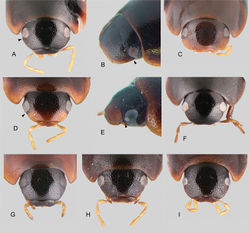Tobochares fusus
| Notice: | This page is derived from the original publication listed below, whose author(s) should always be credited. Further contributors may edit and improve the content of this page and, consequently, need to be credited as well (see page history). Any assessment of factual correctness requires a careful review of the original article as well as of subsequent contributions.
If you are uncertain whether your planned contribution is correct or not, we suggest that you use the associated discussion page instead of editing the page directly. This page should be cited as follows (rationale):
Citation formats to copy and paste
BibTeX: @article{Girón2021ZooKeys1019, RIS/ Endnote: TY - JOUR Wikipedia/ Citizendium: <ref name="Girón2021ZooKeys1019">{{Citation See also the citation download page at the journal. |
Ordo: Coleoptera
Familia: Hydrophilidae
Genus: Tobochares
Name
Tobochares fusus Girón & Short, 2021 sp. nov. – Wikispecies link – ZooBank link – Pensoft Profile
Type material examined
Holotype (male): “Brazil: Amapá: Oiapoque/ 3.85039, -51.81683; 17 m/ Oiapoque (ca. 1 km E); 18.vii.2018/leg. Short; Flotation of detritus/ex forest seep; BR18-0718-03C” (INPA). Paratypes (58 exs.): Brazil: Amapá: Same data as holotype (45, INPA, MNHN, SCC, SEMC including DNA voucher SLE1564); Oiapoque (4 km NE), 3.87234, -51.80315, 14 m, 18.vii.2018, leg. Short, root mats on rock at margin seep, BR18-0718-02A (10, INPA, SEMC); Oiapoque (ca. 5.5 km NE), Balneario, 18.vii.2018, leg. Short, margin of larger stream, BR18-0718-01C (1, SEMC). French Guiana: Savane Roche Virginie, near RN 2, 4.1883, -52.13982, 64 m, 10.iii.2020, leg. Short and Neff, rotting Clusia fruits, FG20-0310-01D (3, SEMC including DNA Voucher SLE2171).
Differential diagnosis
Tobochares fusus is externally indistinguishable from T. emarginatus, given that both species share the same disposition and degree of impression of the elytral punctures, and a low transverse ridge on the posterior elevation of the metaventrite. However, they can be clearly differentiated by the general shape of the aedeagus, which is rather slender and nearly parallel sided in T. emarginatus (Kohlenberg and Short 2017[1]: fig. 14I), whereas T. fusus has a fusiform aedeagus (see Fig. 11C).
Description
Size and form: Body length 1.7–2.0 mm. Body elongate oval, moderately convex (Fig. 5D, E). Color and punctation: Dorsal surfaces of body dark brown, with slightly paler pronotum (Fig. 5D); antennae, mouthparts, and legs yellowish brown, with orange tibiae; ventral surfaces of meso-, metathorax and abdomen dark brown (Fig. 5F). Ground punctation on head, pronotum and elytra moderately marked. Head: Eyes in dorsal view with anterior margin oblique, posteriorly directed; canthus emarginating eye to about a quarter of its dorsal width in lateral view (Fig. 2C). Maxillary palps 0.7 × width of head. Thorax: Elytra with all kinds of punctures similar in size and degree of impression, seemingly evenly distributed, not forming grooves (Fig. 5D). Elevation of mesoventrite forming a low transverse ridge (Fig. 5F). Metaventrite with distinct median, broad, diamond-shaped glabrous area extending along posterior two thirds (Fig. 5F). Abdomen: Abdominal ventrites uniformly and densely pubescent (Fig. 5F). Aedeagus (Fig. 11C). Basal piece nearly 0.4 × length of a paramere; greatest width of a paramere nearly 0.7 × greatest width of median lobe; outer margins of parameres diverging along basal half, then broadly bending inward and tapering along apical fifth; apex of paramere oblique, pointing towards longitudinal midline of aedeagus; median lobe roughly triangular, apically rounded; gonopore situated at apex of median lobe.
Etymology
Named with the Latin word fusus, meaning fusiform, in reference to the shape of the aedeagus of this species.
Distribution
This species is known from two closely situated localities on either side of the Oiapoque River, the boundary between French Guiana and the Brazilian state of Amapá. See Fig. 13.
Life history
The series from Brazil were taken from a seepage habitat in a forested riparian corridor (Fig. 14F). A thin layer of saturated dead leaves was laying over granite, over which a thin film of water was seeping into an adjacent stream. The short series from French Guiana was collected from the rotting fruits of a Clusia on an otherwise dry forest floor and not adjacent to any aquatic habitat (Fig. 17C).
Original Description
- Girón, J; Short, A; 2021: Review of the Neotropical water scavenger beetle genus Tobochares Short & García, 2007 (Coleoptera, Hydrophilidae, Acidocerinae): new lineages, new species, and new records ZooKeys, 1019: 93-140. doi
Images
|
Other References
- ↑ Kohlenberg A, Short A (2017) Revision of the Neotropical water scavenger beetle genus Tobochares Short and García, 2007 (Coleoptera, Hydrophilidae, Acidocerinae).ZooKeys669: 113–146. https://doi.org/10.3897/zookeys.669.11773





